#Heloderma suspectum
Text

A gila monster (Heloderma suspectum) wanders through a backyard in the Sonoran Desert, Arizona, USA
by troupial
#gila monster#beaded lizards#lizards#reptiles#heloderma suspectum#heloderma#helodermatidae#squamata#reptilia#chordata#wildlife: arizona#wildlife: usa#wildlife: north america
60 notes
·
View notes
Text



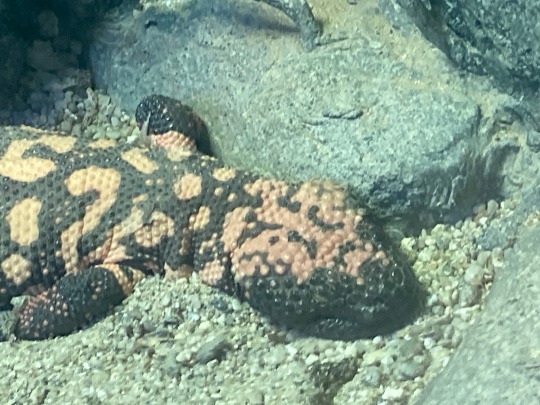
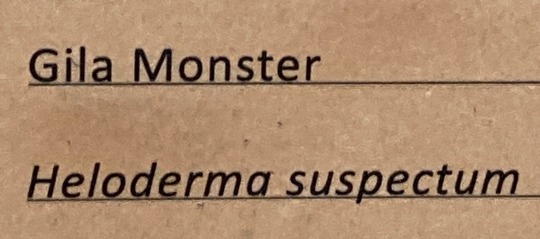
16 notes
·
View notes
Text


Got two 1:1 pairs of goofy-af CB Gilas
0 notes
Text

Gila Monster (Heloderma suspectum), family Helodermatidae, SW United States
Mildly venomous.
photograph by Greg Lit
#gila monster#heloderma#helodermatidae#lizard#veonmous#reptile#herpetology#animals#nature#north america
750 notes
·
View notes
Text

Gila monster (Heloderma suspectum)
Reptiles and Amphibians of the World. Written by Hans Hvass. Illustrated by Wilhelm Eigener. Originally published in 1958.
Internet Archive
243 notes
·
View notes
Text

HELODERMA SUSPECTUM
181 notes
·
View notes
Text
Uncharismatic Fact of the Day
Gila monsters may look ferocious, but they’re really quite lazy. These lizards spend most of their day soaking up the sun to maintain their internal temperature, and a group of them is called a lounge.

(Image: A lazy gila monster (Heloderma suspectum) by the National Park Service of the United States)
If you like what I do, consider leaving a tip or buying me a kofi!
322 notes
·
View notes
Photo
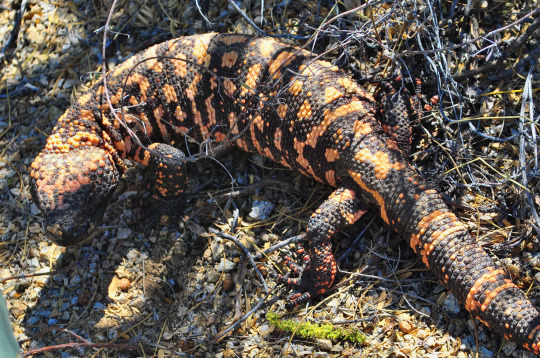
Gila Monster (Heloderma suspectum), Saguaro National Park, Arizona.
668 notes
·
View notes
Text
i hate that the english name for heloderma suspectum is "gila monster" like damn it's just a colorful little guy
10 notes
·
View notes
Text

🟪 ANIMAL OF THE DAY: Gila monster. Heloderma suspectum. a North American lizard that is venomous but too slow to really do anything about it when Threatened. (this is the Part where you all reply with "same." it is a very funny reply)
45 notes
·
View notes
Text

Heloderma suspectum, Gila Monster. Captive. Arizona-Sonora Desert Museum. April 2022.
#nature photography#animal photography#gila monster#photography#my photography#april 2022#2022#arizona-sonora desert museum#sonoran desert#desert#lizards
21 notes
·
View notes
Text
A venomous lizard, a rare iguana, and a cactus “tree”.
Check out this weird relationship among two of the planet’s rarest and most endangered reptiles and this cactus.
Thinking about Gila monsters and beaded lizards as emblems, icons of the Pacific coast of Mexico. How these unique, enchanting, superlative, venomous lizards are so closely associated with the landscapes along the Pacific between the Mojave Desert and the mountains of Guatemala.
It turns out that there have been 2 more unique species of Gila monster/beaded lizard hiding in plain sight. (Subspecies which are now technically considered to be unique species.) 2 “new” Gila monsters. One of theses lives in the tropical dry forest and scrub of the Motagua Valley, where organ pipe cactus and thornscrub give this Guatemalan habitat a look kinda like the Sonoran Desert. Here lives the Motagua beaded lizard, one of the rarest and most endangered reptiles on the planet. The other “new” species is the Chiapan beaded lizard. Look at this venomous lizard and its unique habitat in the tropical mountains of Chiapas:

And one of the iconic creatures of this imaginative coast: Gila monsters. Since Linnaean taxonomic classification is a loose and ever-changing and fallible way to attempt to categorize living things, let’s just say that beaded lizards are similar enough that I just consider them, basically, to be Gila monsters. All together, there are 6 subspecies, 6 variations, of these venomous lizards. And there are two of these venomous lizards that don’t really get talked about too much despite their extra-cool lifestyles. They were recently determined to be unique species.
Landscapes can be perceived as the product of the human imagination, right? I adore the Pacific Rim, but I especially love the Pacific coast of the Americas. The edge of the world. Globally-unique Mediterranean-climate chaparral of both California and Chile. The planet’s most extensive temperate rainforests in both the Pacific Northwest and Valdivia. The Sonoran Desert, the vibrant sea of the Gulf of California, tropical mountains of Chiapas, the fog oases of the Atacama Desert, volcanoes, the fjordlands and “miniature forests” of the Magellanic region. Run away from Europe, try to escape the panopticon of industrial Europe and its history, go as far west as you can, and you reach the Pacific coast of the Americas.
Beyond this coast? The vast Pacific ocean, nearly boundless seas, the tropical South Pacific, Aotearoa. You could leave the coast of Sonora and sail without encountering human beings or land until you reached the frozen world of Antarctica.
Here be dragons, or whatever.
Here’s where the “dragons” live. Distribution map of the Gila monsters that I made using “working-class GIS” (M!crosoft Paint):

Check it out, from north to south.
Heloderma suspectum cinctum. The “banded Gila monster”, though I prefer to think of it with a more ecologically meaningful name like the “Mojave Desert Gila Monster” or “Colorado River Gila monster”. Lives along the Colorado River near the Grand Canyon and Las Vegas.
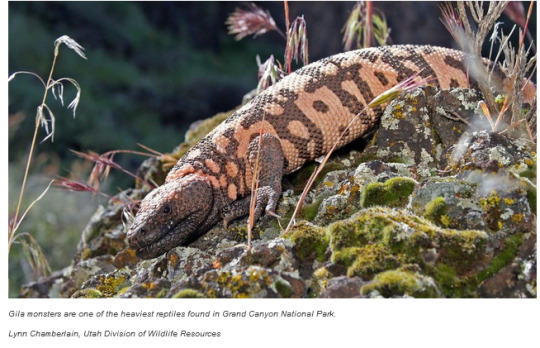
Heloderma suspectum suspectum. The “reticulate Gila monster”, though I prefer the more ecologically meaningful name “Sonoran Desert Gila monster”, since its distribution range is essentially an outline of the Sonoran Desert bioregion.

Heloderma horridum exasperatum. The “Rio Fuerte beaded lizard”, though I prefer to think of it as the “Sinaloan beaded lizard” or “Sinaloan thornscrub beaded lizard”.

Heloderma horridum horridum. The “Mexican beaded lizard”.

Heloderma alvarezi. The “Chiapan beaded lizard” which only lives in a small/limited range in the mountains of Chiapas.

And finally.
Heloderma charlesbogerti. The “Guatemalan beaded lizard” or “Motagua beaded lizard” of the Motagua Valley, critically endangered.

Less than 200 survive in the wild. One of the rarest and most endangered reptiles on the planet.
And get this. For food, it relies on the eggs of the Motagua spiny-tailed iguana. The Motagua spiny-tailed iguana is itself also highly endangered, with less than 2,500 surviving animals, and also only endemic to this one single valley.
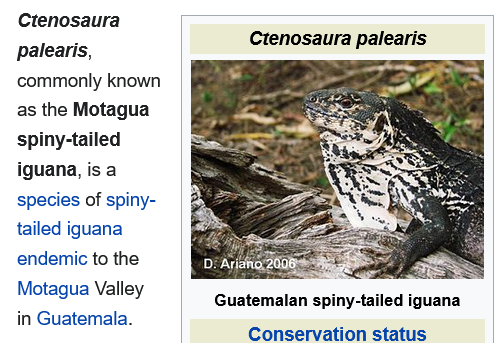
That’s two lizards, found nowhere else, in an intimate relationship, nearly extinct.
But that’s not all. For food, the Motagua spiny-tailed iguana itself relies on the fruit of several cactus species. One is Pereskia lychnidiflora. Pereskia is one of the two only known genus/genera of cactus where the cactus essentially produces leaves.
Making this cactus a “tree”.
And the “tree” spreads itself thanks to the iguana’s fruit consumption.

Wild.
Some dragons and a cactus tree.
Planet is full of magic.
120 notes
·
View notes
Note
Hello hope this is okay, was wondering if you knew what the biggest lizard and the smallest lizard that natural habit is in North America? I know I could Google it and get my answer, but I like to ask people about things they are interested in/know a lot about.
Ok, so I 'm going to make this easier on myself, and change this to:
Largest and smallest lizards found int he United States.
Here you go...
Largest lizard found in the US:

Gila Monster (Heloderma suspectum), family Helodermatidae, found in the SW United States and northern Mexico
Venomous.
This lizard grows to 56 cm (22 in) long (total length).
photograph by Vaclav
Smallest Lizard in the US:

Florida Reef Gecko (Sphaerodactylus n. notatus), family Sphaerodactylidae, found in the Florida Keys and other islands in the Caribbean
This tiny lizard only grows to total length of up to 5 cm (2 in).
There is debate about whether the species was introduced into the Florida Keys from shipping, or distributed into the island naturally from another part of the Caribbean, though rafting on oceanic debris.
photograph by John William Bailly
235 notes
·
View notes
Text

Grzimek's Animal Life Encyclopedia. Volume 6: Reptiles. Written by Bernard Grzimek. 1984.
1.) Mexican beaded lizard (Heloderma horridum)
2.) Gila monster (Heloderma suspectum)
3.) Earless monitor lizard (Lanthanotus borneensis)
4.) Angled worm lizard (Agamodon anguliceps)
5.) Checkerboard worm lizard (Trogonophis wiegmanni)
6.) Cape worm lizard (Monopeltis capensis)
7.) Red worm lizard (Amphisbaena alba)
8.) Four-toed worm lizard (Bipes canaliculatus)
#reptiles#lizards#mexican beaded lizards#gila monsters#earless monitor lizards#angled worm lizards#cape worm lizards#red worm lizards#four-toed worm lizards
99 notes
·
View notes

